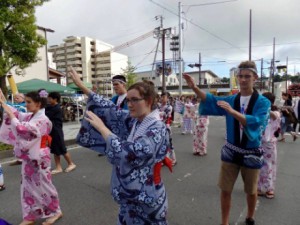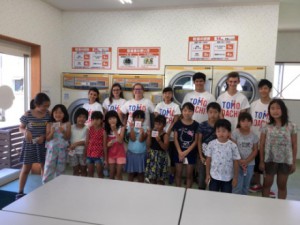セントルイスの高校生が文化交流プログラムで石巻を訪問、東日本大震災について学ぶ
「2016 TOMODACHI セントルイス・石巻友情プログラム」で、米国ミズーリ州セントルイスの高校生5名が2週間石巻市を訪問し、ホームステイや石巻市内のスタディーツアーに参加しました。石巻市は、東日本大震災により甚大な被害を受け復興に向かい取り組んでいます。今年4年目を迎えた本プログラムは、毎年交互に両国を訪問する文化交流プログラムです。
 本プログラムのハイライトとして、毎年開催の「石巻川開き祭り」に参加し、パレードに参列しました。また、石巻の基幹産業である漁業の玄関口、石巻魚市場への訪問や、漁船乗船体験では、帆立やわかめの養殖業の復興への歩みを学びました。その他、茶道や中学校への訪問で日本の教育システムについて学ぶ等、日本文化に触れました。一行は、村上英人蔵王町長や亀山紘石巻市長と面会し、震災時の状況や復興への取り組みについて学びを深める機会となりました。
本プログラムのハイライトとして、毎年開催の「石巻川開き祭り」に参加し、パレードに参列しました。また、石巻の基幹産業である漁業の玄関口、石巻魚市場への訪問や、漁船乗船体験では、帆立やわかめの養殖業の復興への歩みを学びました。その他、茶道や中学校への訪問で日本の教育システムについて学ぶ等、日本文化に触れました。一行は、村上英人蔵王町長や亀山紘石巻市長と面会し、震災時の状況や復興への取り組みについて学びを深める機会となりました。
 最終日には、プログラムでの経験や学び、気付き等を最終プレゼンテーションとして集約し、これまで本プログラム実現にご協力いただいたコーディネーターやボランティア、ホストファミリー、過去プログラム参加者を前に日英両言語で発表しました。集まった関係者が、生徒達のプレゼンテーションに心を動かされ、涙を流す場面も見受けられました。
最終日には、プログラムでの経験や学び、気付き等を最終プレゼンテーションとして集約し、これまで本プログラム実現にご協力いただいたコーディネーターやボランティア、ホストファミリー、過去プログラム参加者を前に日英両言語で発表しました。集まった関係者が、生徒達のプレゼンテーションに心を動かされ、涙を流す場面も見受けられました。
今年も本プログラムを通して、日米高校生の友情の構築、草の根文化交流、米国人高校生の東日本大震災に対する学びの深化等を実現しました。異文化体験にはじまり、被災地訪問や地域住民の方々との交流での実体験、日米生徒同士で育む友情関係など、さまざまな経験を経て大変貴重な機会となりました。



